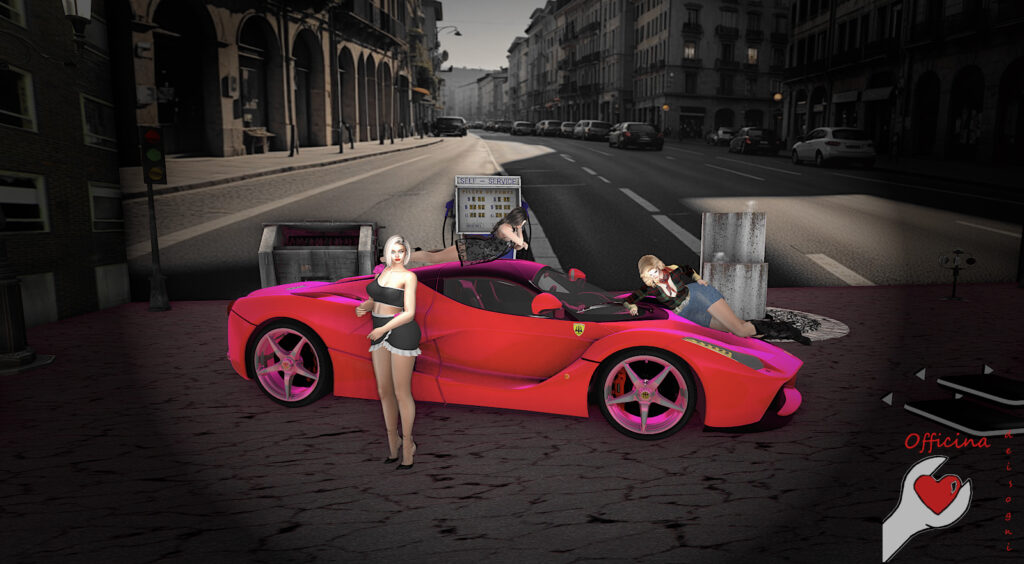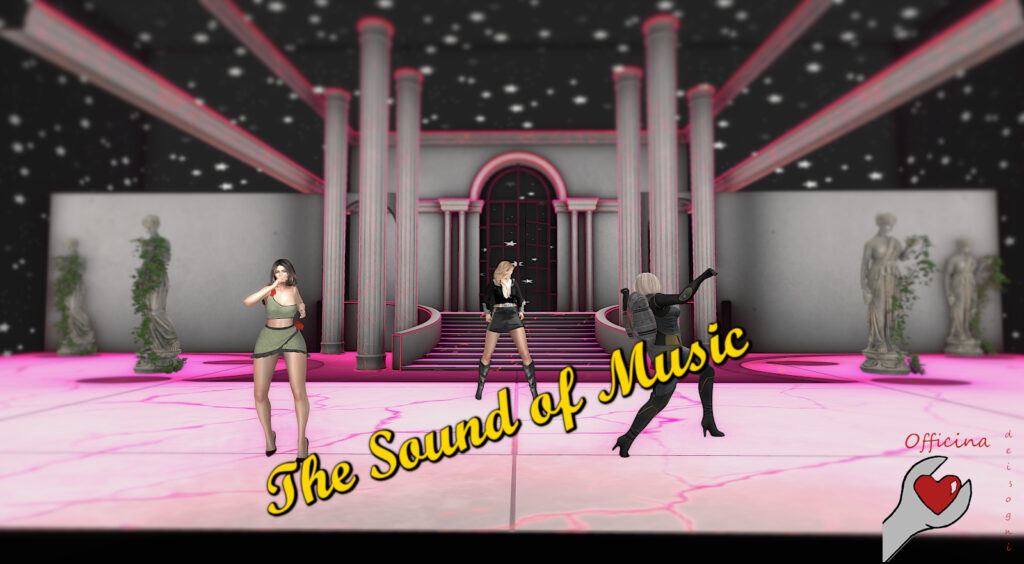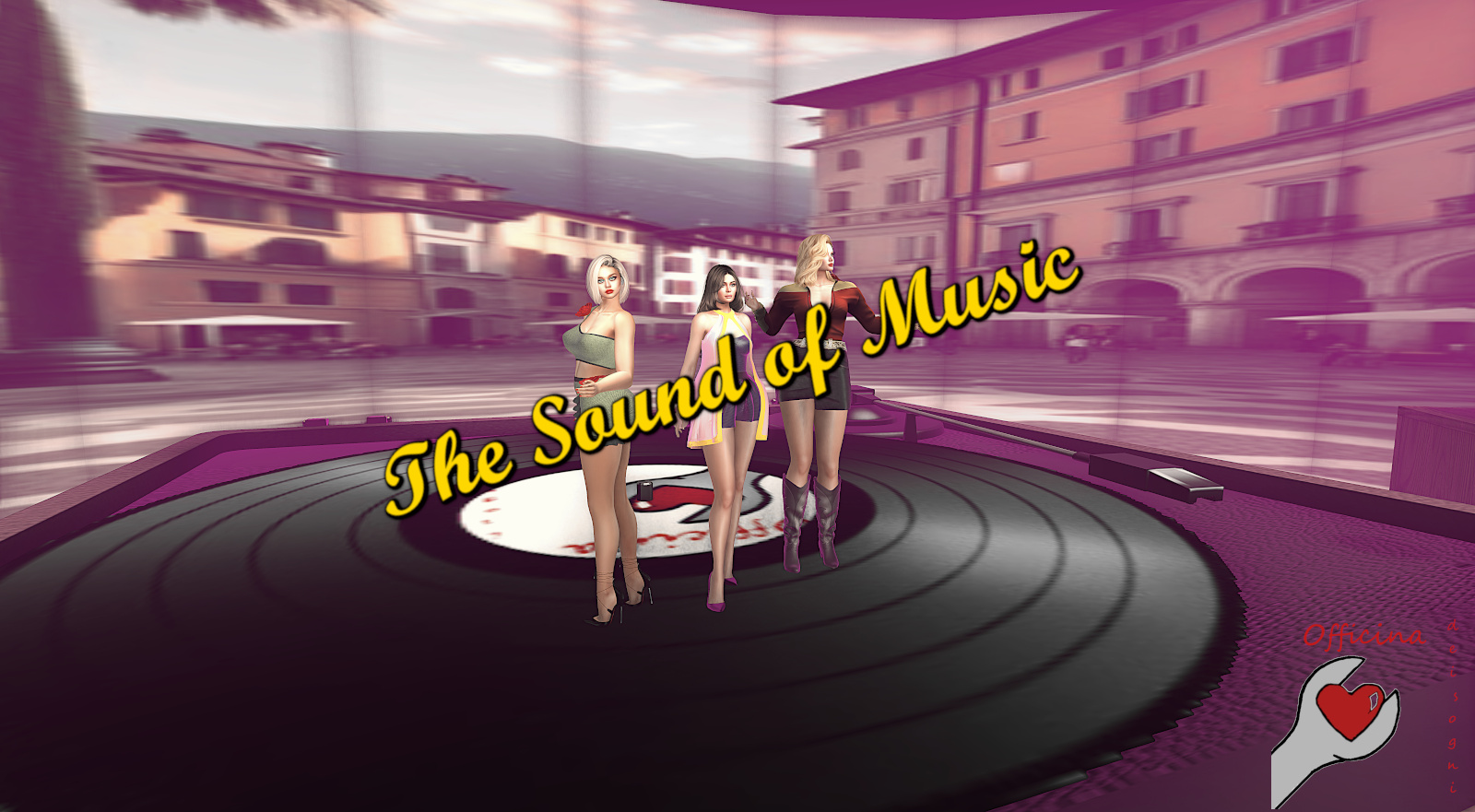Next generation show: The Sound of Music – Release Notes
English Version here.
[For German Version click here]
[For Italian Version click here]
The show is about the evolution of music in the last hundred years. In the past, music was either sacred or very expensive. Today, all it takes is one click and some algorithms knows better than you do which beat motivates you. In the 19th century, music pretended to be a distinguished duchess: everything strictly according to the score, nicely in time, hair beautifully blow-dried. Beethoven for tea, Chopin for the night. The most important accessories: tailcoat, violin, serious look.
Then, suddenly, the 20th century and the progress of media (radio, TV, internet) bursts into the music like a teenager on roller skates and shouts: “Let’s do everything differently!”
Media diffusion through radio and television led to the explosion of international singer-songwriter music, characterized by a great variety of styles and artists, but it can be identified with the birth of a new type of artist: the singer-songwriter, who writes and performs his own songs. They have profoundly influenced not only music, but all culture.
Much of the show was written for the Sim who commissioned it, and who proposed the subject to us: the Cupidus Club, an abandoned space station shrouded in silence and memories, but now its old corridors glow with pulsating light, music vibrates through rusty steel walls, and dancers float weightlessly under sparkling neon lights.
Okay, for a show in an abandoned station floating in the space, the reference to the interstellar space absolutely cannot be missing. We’ve highlighted this in several passages, sending a team of space fairies to light up the constellations in the northern sky under the gaze of an astronaut musician, but also projecting a famous Italian singer like Mina into a whirlwind race through hyperspace, enveloped in a magnetic field that emits notes and accelerates her to speeds approaching the speed of light. Even in the finale, the reference to interstellar travel is underscored, with a tribute (which was inevitable, given the show’s theme) to Pink Floyd‘s visual and luminous constructions.
Another important reference, prominent throughout the show, is the 1970s, the golden age of free radio and music that was beginning to circulate widely in homes. That era is portrayed as it was: years of hope, joy, and commitment to a better and more peaceful future. This peaceful future, in fact, becomes a remarkably natural topic of current interest.
From a strictly technical standpoint, still with reference to space, we focused heavily on the movement not only of actresses, actors, and dancers, but also of objects. We adopted the software development convention of translating objects server-side but offloading the rotations to the user viewers, thus attempting to reduce lag by dividing the processing between the server and the viewers.
Still on a technical level, to enhance the representation of interstellar space, we used a large number of EEP environment changes, some of which were very rapid. We also created a highly light-absorbing stage at the end, reinforcing the idea of sidereal darkness.
Non-PBR textures were kept to a minimum, and a reflection probe was inserted that occupies the entire performance space.
The animations were generally drawn at 25FPS, with a few exceptions where we preferred 48FPS for perfect synchronization with the messages sent by the Second Life server. The large number of 25FPS animations should ensure a smooth experience of the show even on particularly slow internet connections. In any case, we precached not only the animations, but also all the scenery and textures.
Similarly, all particle emitter systems were created in-house, as were the costume textures.
For the scenes, trying to preserve as much of the important scenic details as possible, we designed meshes with a low number of vertices and triangles, ensuring rapid rezzing and rendering times without overly tiring the viewer.
For the camera angles, fearing the flickering that always lurks in laggy or crowded sims, we chose to avoid camera movements and adopt a strict policy of static camera sequences.
This time, we’ve also benefited from valuable collaborations, first and foremost that of Metaharper Immersive Theater, represented by Arrehn Oberlander.
On a personal level, this work was made possible thanks to the invaluable collaboration of Musa InFabula for all musical and philological aspects; Alex Cat for the creation of the particles, for his advice on software production, and for introducing a true software product lifecycle management process into the team; Clarissa Bughuntress for her usual (and aggressive) attention to detail and defects; Dahlia Dust for her dedication to testing every single aspect; and Sajushi von Firlefanz for giving us the idea for the show and for hir contribution to the story and texts.
In the next few days, we’ll be conducting a beta test (closed to the public) that could serve as a general practice and dress rehearsal, after which the show will be scheduled, so… stay tuned, The Sound of Music is coming!
The Sound of Music – German Version

Die Show handelt von der Entwicklung der Musik in den letzten hundert Jahren. Früher war Musik entweder sakral oder sehr teuer. Heute genügt ein Klick, und Algorithmen wissen besser als Du selbst, welcher Beat Dich motiviert. Im 19. Jahrhundert gab sich die Musik wie eine vornehme Herzogin: alles streng nach Partitur, schön im Takt, die Haare wunderschön geföhnt. Beethoven zum Tee, Chopin für die Nacht. Die wichtigsten Accessoires: Frack, Geige, ernster Blick.
Dann, plötzlich, bricht das 20. Jahrhundert und der Fortschritt der Medien (Radio, Fernsehen, Internet) wie ein Teenager auf Rollschuhen in die Musik ein und ruft: „Lasst uns alles anders machen!“
Die Verbreitung der Medien durch Radio und Fernsehen führte zu einer Explosion der internationalen Musik, die sich durch eine große Vielfalt an Stilen und Künstlern auszeichnet, und mit der Geburt einer neuen Art von Künstlern identifiziert werden kann: den Singer-Songwritern, die ihre eigenen Songs schreiben und aufführen. Sie haben nicht nur die Musik, sondern die gesamte Kultur tiefgreifend beeinflusst.
Ein Großteil der Show wurde für den Auftraggeber konzipiert, der das Thema vorgeschlagen hat: Der Club Cupidus. Eine verlassene Raumstation, die von Stille und Erinnerungen umhüllt ist, deren alte Korridore nun jedoch in pulsierendem Licht erstrahlen, Musik durch rostige Stahlwände vibriert und Tänzer schwerelos unter funkelnden Neonlichtern schweben.
Okay, für eine Show in einer verlassenen Station, die im Weltraum schwebt, darf der Verweis auf den interstellaren Raum auf keinen Fall fehlen.
Wir haben dies in mehreren Passagen hervorgehoben, indem wir ein Team von Weltraumfeen losgeschickt haben, um die Konstellationen am Nordhimmel unter den Blicken eines Astronautenmusikers zu beleuchten, aber auch indem wir eine berühmte italienische Sängerin wie Mina in ein rasantes Rennen durch den Hyperraum projiziert haben, umhüllt von einem Magnetfeld, das Töne aussendet und sie auf Geschwindigkeiten beschleunigt, die sich der Lichtgeschwindigkeit annähern.
Selbst im Finale wird der Bezug zur interstellaren Reise unterstrichen, mit einer Hommage (die angesichts des Themas der Show unvermeidlich war) an die visuellen und leuchtenden Konstruktionen von Pink Floyd.
Ein weiterer wichtiger Bezug, der sich durch die gesamte Show zieht, sind die 1970er Jahre, das goldene Zeitalter des freien Radios und der Musik. Diese Ära wird so dargestellt, wie sie war: Jahre der Hoffnung, der Freude und des Engagements für eine bessere und friedlichere Zukunft. Diese friedliche Zukunft wird in der Tat zu einem bemerkenswert natürlichen Thema von aktuellem Interesse.
Aus rein technischer Sicht haben wir uns, immer noch in Bezug auf den Raum, stark auf die Bewegung nicht nur von Schauspielerinnen, Schauspielern und Tänzern, sondern auch von Objekten konzentriert. Wir haben die Softwareentwicklungskonvention übernommen, Objekte serverseitig zu übersetzen, aber die Rotationen auf die Viewer der Benutzer auszulagern, um so die Verzögerung durch die Aufteilung der Verarbeitung zwischen Server und Viewern zu reduzieren.
Um die Darstellung des interstellaren Raums zu verbessern, haben wir auf technischer Ebene eine große Anzahl von EEP-Umgebungsänderungen verwendet, von denen einige sehr schnell ablaufen. Außerdem haben wir am Ende eine stark lichtabsorbierende Bühne geschaffen, um die Vorstellung von Dunkelheit zu verstärken.
Nicht-PBR-Texturen wurden auf ein Minimum beschränkt, und es wurde eine Reflektionssonde eingefügt, die den gesamten Aufführungsraum einnimmt.
Die Animationen wurden in der Regel mit 25 FPS gezeichnet, mit wenigen Ausnahmen, bei denen wir 48 FPS bevorzugten, um eine perfekte Synchronisation mit den vom Second Life-Server gesendeten Nachrichten zu erreichen. Die große Anzahl von 25-FPS-Animationen sollte auch bei besonders langsamen Internetverbindungen ein flüssiges Erlebnis der Show gewährleisten. In jedem Fall haben wir nicht nur die Animationen, sondern auch alle Kulissen und Texturen vorab zwischengespeichert.
Ebenso wurden alle Partikelemittersysteme intern erstellt, ebenso wie die Kostümtexturen. Um möglichst viele wichtige Details der Szenerie zu erhalten, haben wir Meshes mit einer geringen Anzahl von Scheitelpunkten und Dreiecken entworfen, um schnelle Lade- und Renderzeiten zu gewährleisten, ohne den Betrachter übermäßig zu ermüden. Was die Kamerawinkel angeht, haben wir uns aus Angst vor dem Flackern, das bei verzögerten oder überfüllten Sims immer lauert, dafür entschieden, Kamerabewegungen zu vermeiden und eine strikte Politik statischer Kamerasequenzen zu verfolgen.
Dieses Mal haben wir auch von wertvollen Kooperationen profitiert, allen voran von der Zusammenarbeit mit Metaharper Immersive Theater, vertreten durch Arrehn Oberlander.
Auf persönlicher Ebene wurde diese Arbeit dank der unschätzbaren Zusammenarbeit mit Musa InFabula in allen musikalischen und philologischen Aspekten ermöglicht. Alex Cat für die Erstellung der Partikel, für seine Beratung zur Softwareproduktion und für die Einführung eines echten Software-Produktlebenszyklus-Managementprozesses im Team; Clarissa Bughuntress für ihre gewohnte (und aggressive) Liebe zum Detail und zur Fehlerbehebung; Dahlia Dust für ihr Engagement beim Testen jedes einzelnen Aspekts; und Sajushi von Firlefanz für die Idee zur Show und für seinen Beitrag zur Geschichte und zu den Texten.
In den nächsten Tagen werden wir einen Beta-Test (geschlossen für die Öffentlichkeit) durchführen, der als allgemeine Übung und Generalprobe dienen könnte. Danach wird die Show geplant, also… bleiben Sie dran, The Sound of Music kommt!
The Sound of Music – Note di rilascio

Lo spettacolo racconta l’evoluzione della musica negli ultimi cento anni. In passato, la musica era sacra o molto costosa. Oggi, basta un clic e alcuni algoritmi sanno meglio di te quale ritmo ti motiva. Nel XIX secolo, la musica fingeva di essere una distinta duchessa: tutto rigorosamente secondo lo spartito, a tempo, capelli splendidamente asciugati. Beethoven per il tè, Chopin per la sera. Gli accessori più importanti: frac, violino, sguardo serio.
Poi, all’improvviso, il XX secolo e il progresso dei media (radio, TV, internet) irrompe nella musica come un adolescente sui pattini a rotelle e grida: “Facciamo tutto diversamente!”.
La diffusione dei media attraverso radio e televisione ha portato all’esplosione della musica cantautorale internazionale, caratterizzata da una grande varietà di stili e artisti, ma può essere identificata con la nascita di una nuova tipologia di artista: il cantautore, che scrive ed esegue le proprie canzoni. I cantautori hanno influenzato profondamente non solo la musica, ma tutta la cultura.
Gran parte dello spettacolo è stato scritto per il Sim che lo ha commissionato e che ci ha proposto il soggetto: il Cupidus Club, una stazione spaziale abbandonata avvolta nel silenzio e nei ricordi, ma ora i suoi vecchi corridoi brillano di luci pulsanti, la musica vibra attraverso le pareti d’acciaio arrugginito e i ballerini fluttuano senza peso sotto scintillanti luci al neon.
D’accordo, per uno spettacolo ambientato in una stazione spaziale abbandonata che fluttua nello spazio, il riferimento allo spazio interstellare non poteva assolutamente mancare. Lo abbiamo evidenziato in diversi passaggi, mandando una squadra di fatine spaziali ad accendere le costellazioni del cielo boreale sotto lo sguardo di un musicista astronauta, ma anche proiettando una famosa cantante italiana come Mina in una vorticosa corsa nell’iperspazio, avvolta da un campo magnetico che emette note e la accelera a velocità prossime a quella della luce. Anche nel finale, viene sottolineato il riferimento ai viaggi interstellari, con un omaggio (che non poteva mancare, visto il tema dello show) alle costruzioni visuali e luminose dei Pink Floyd.
Un altro riferimento importante, e ben presente nello show, è quello agli anni ’70, epoca d’oro delle radio libere e della musica che iniziava a circolare in modo massiccio nelle case. Quell’epoca viene rappresentata come quel che è stato: anni di speranze, di gioie, di impegno per un futuro migliore e pacifico. Proprio il futuro pacifico, diventa in modo straordinariamente naturale un tema di attualità.
Dal punto di vista strettamente tecnico, sempre come riferimento allo spazio, abbiamo puntato molto sul movimento non solo di attrici, attori e ballerine, ma anche di oggetti. Abbiamo adottato la convenzione, nella scrittura del software, di traslare gli oggetti server side ma di scaricare il compito di realizzare le rotazioni ai viewer degli utenti, in modo da tentare di ridurre il lag, suddividendo le elaborazioni da fare tra server e viewer. In generale tutta il software prodotto segue i nostri consueti criteri di ottimizzazione circa la lunghezza delle liste di dati, i buffer di scambio dati, eccetera, per tentare di minimizzare il carico di CPU sia nelle elaborazioni del server sia nel rendering del viewer. Su questo fronte molto può ancora essere migliorato, ma per questo attendiamo le prossime versioni di SL (SLua).
Ancora sul piano tecnico, per dare forza alla rappresentazione dello spazio interstellare, abbiamo adottato un numero elevato di cambi di ambiente EEP, alcuni dei quali molto rapidi, così come nel finale abbiamo realizzato uno stage fortemente assorbente della luminosità, per rafforzare l’idea del buio siderale.
Le texture non-pbr sono state ridotte al minimo, ed è stata inserita una sonda di riflessione che occupa tutto lo spazio della performance.
Le animazioni sono state disegnate generalmente a 25FPS, tranne alcune eccezioni dove abbiamo preferito 48FPS per avere una perfetta sincronizzazione con i messaggi inviati dal server di Secondlife. La massiccia presenza di animazioni a 25FPS dovrebbe garantire una buona fruizione dello show anche in caso di connessioni internet particolarmente lente. In ogni caso abbiamo previsto un precaching non solo delle animazioni, ma anche di tutte le scenografie e delle textures.
Analogamente tutti i sistemi di emettitori di particelle sono stati realizzati internamente, così come le textures dei costumi.
Per le scene, cercando di salvare il più possibile i dettagli scenografici importanti, abbiamo disegnato mesh con basso nunero di vertici e triangoli, in modo da garantire rapidi tempi di rezzing e di rendering, senza affaticare troppo il viewer.
Per gli angoli delle telecamere, temendo del flickering sempre in agguato nelle sim laggate o affollate, abbiamo scelto di evitare movimenti di camera, e di adottare una severa politica di sequenze di camere statiche.
Ci siamo avvalsi anche questa volta di preziose collaborazioni, prima tra tutte quella di Metaharper Immersive Theater nella persona di Arrehn Oberlander.
Sul piano personale, invece, questo lavoro è stato possibile grazie alla preziosa collaborazione di Musa InFabula per tutto quello che riguarda gli aspetti musicali e filologici, Alex Cat, per la realizzazione delle particelle, per i buoni consigli sulla produzione softare, e per aver introdotto nel team un vero processo di gestione del ciclo di vita di un prodotto software, Clarissa Bughuntress per la sua consueta (e aggressiva) attenzione ai dettagli e ai difetti, Dahlia Dust per l’essersi dedicata al collaudo di ogni singolo aspetto, Sajushi von Firlefanz per averci dato l’idea dello spettacolo e per il contributo alla stesura del soggetto e dei testi.
Nei prossimi giorni, effettueremo un Beta Test (chiuso al pubblico) che potrebbe valere come prova generale, dopodichè lo show verrà messo in calendario, quindi… restate sintonizzati, The Sound of Music sta arrivando!



